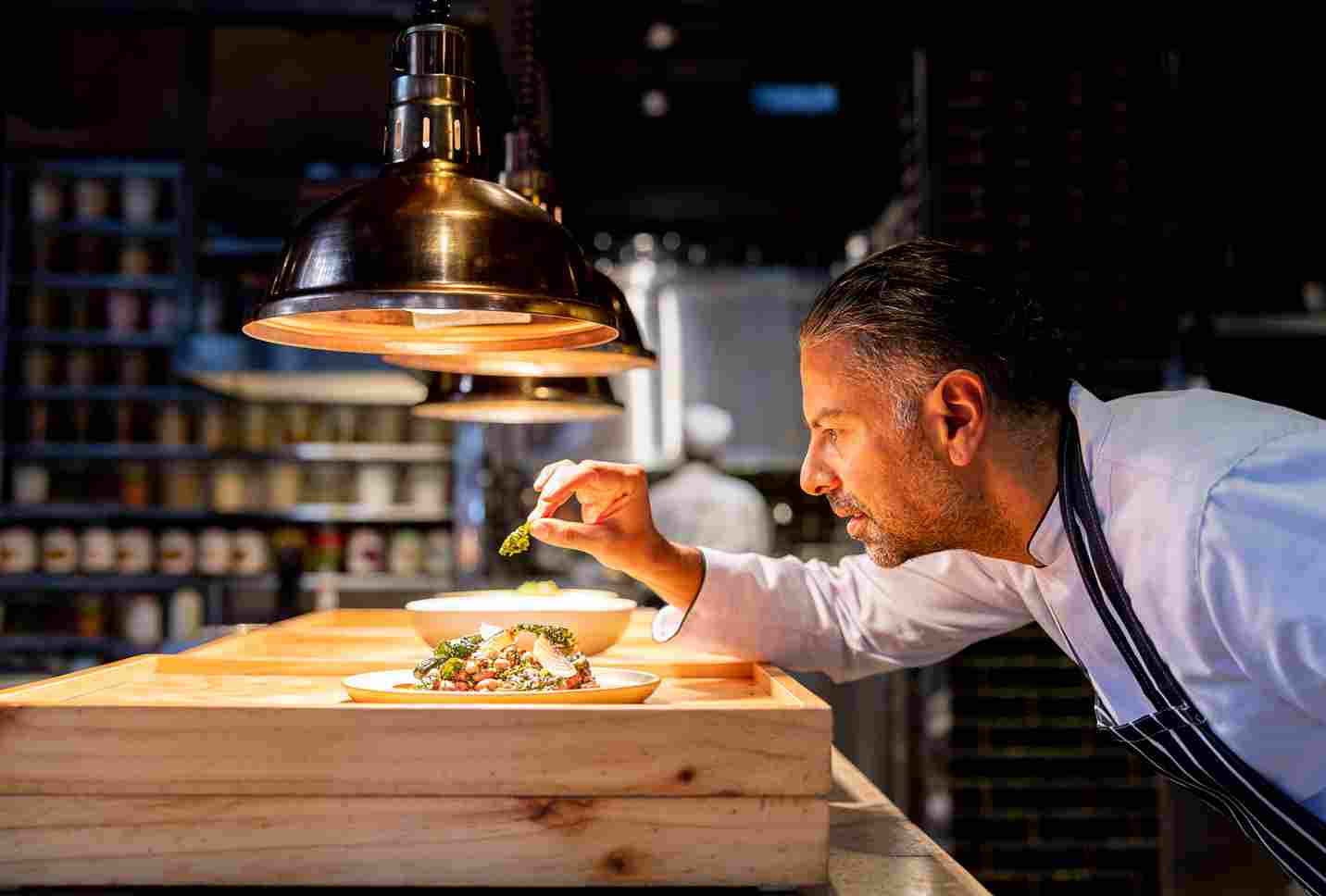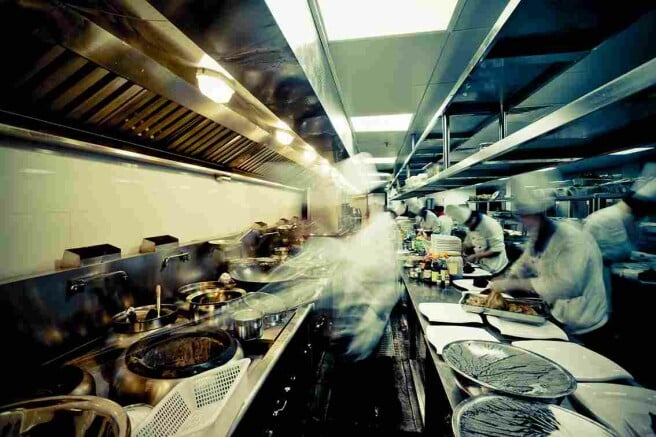Rise through the ranks: life as a chef de partie

Behind the scenes of every successful kitchen, there's a team of dedicated professionals, each playing a role in delivering culinary excellence. Among them is the chef de partie, a pivotal position where passion meets precision, creativity blends with discipline and talent rises to the forefront. With around 23,600 new chef de partie jobs expected by 2034 and an average salary of $52,000, this can be an appealing role. Join us as we look into this culinary craftsmanship, exploring what life is like as a chef de partie.
What is a chef de partie?
From the French and meaning ‘head of the section’, this title signifies a chef who oversees a specific area or station within the kitchen.
While the role may vary slightly depending on the size and structure of the kitchen, the essence remains the same. A chef de partie is entrusted with a particular aspect of the menu, whether it's sauces, pastries, meats or seafood.
Beyond their culinary skills, chefs de partie are also adept leaders and team players. They work closely with other kitchen staff, ensuring seamless collaboration and timely delivery of dishes.
They also play a vital role in training and mentoring junior chefs, passing their knowledge and expertise on to the next generation of culinary talent. On top of this, any chef de partie has to have a passion for food.
Key responsibilities and duties of a chef de partie
The duties and responsibilities that define the role of a chef de partie can be split up into several different areas. All of these are equally important and a chef has to bear these in mind every day. They are:
Culinary mastery:
-
Execute dishes with precision and consistency, adhering to the highest standards of quality and presentation
-
Demonstrate proficiency with cooking skills, whether it's butchery, pastry, fish, sauces or other specialized areas
-
Innovate and refine recipes, bringing creativity and flair to the menu while respecting the culinary vision of the head chef
Station management:
-
Oversee a designated station within the kitchen, ensuring all aspects of preparation, cooking and plating are executed flawlessly
-
Maintain inventory levels and order supplies as needed to ensure smooth operations
-
Organize and prioritize tasks to meet service deadlines, managing workload effectively during busy periods
Leadership and teamwork:
-
Lead by example, inspiring and motivating fellow kitchen staff to uphold the highest standards of excellence
-
Provide guidance and support to junior chefs, encouraging their growth and development in the kitchen environment
-
Build a collaborative and harmonious atmosphere in the kitchen, promoting effective communication and teamwork among all team members
Quality control and food safety:
-
Monitor food quality throughout the cooking process, ensuring all dishes meet high standards of taste, texture and appearance
-
Adhere to strict food safety protocols and sanitation guidelines, maintaining hygiene standards at all times
-
Perform regular inspections of equipment and storage areas to ensure compliance with health and safety regulations
Menu development and adaptation
-
Collaborate with the head chef and culinary team to develop new menu items and seasonal specials, drawing inspiration from culinary trends and customer preferences
-
Adapt recipes and cooking techniques to accommodate dietary restrictions and special requests, ensuring all guests have a great dining experience
What is it like to work in the culinary industry?
From the sizzle of a hot pan to the artistry of plating a masterpiece dish, working in commercial kitchens offers a unique blend of challenges and rewards that captivate the senses and ignite the imagination.
Here's a glimpse into what it's like to work in this exhilarating profession.
Fast-paced environment
In bustling kitchens, chefs work tirelessly to meet the demands of a busy service, juggling multiple tasks and coordinating team members to ensure smooth operations.
The adrenaline rush of a busy dinner service is exhilarating and demanding, requiring chefs to stay focused, organized and efficient under pressure.
Creativity and innovation
Chefs are constantly pushing the boundaries of flavor, texture and presentation, experimenting with new ingredients, techniques and culinary concepts.
Whether they're reinventing classic dishes or creating avant-garde creations, chefs have the opportunity to express their artistic vision and leave a lasting impression on diners.
Collaboration and teamwork
In the kitchen, chefs work together as a cohesive unit, supporting one another, sharing knowledge and expertise and rallying behind a common goal of delivering exceptional dining experiences.
The camaraderie and sense of teamwork that develop among kitchen staff builds a supportive work environment.
Long hours
Chefs often start their day early, preparing ingredients, planning menus and setting up their stations before service begins.
During peak hours, they may work tirelessly on their feet, maneuvering through tight spaces and handling heavy equipment with precision and agility.
While the hours can be grueling, the sense of accomplishment that comes from delivering flawless dishes makes it all worthwhile.
Passion and dedication
Fueled by a deep love of food, chefs aspire to create memorable dining experiences with every dish they serve.
This passion infuses every aspect of their work, from the meticulous attention to detail in recipe development to the unwavering pursuit of perfection in execution.

Specializations within the chef de partie position
Each of the different sections a chef can manage represents a unique culinary discipline and requires a specific set of skills and expertise.
Some of the most common types of chef someone in this role can specialize as include:
-
Saucier (sauce chef): responsible for preparing and perfecting a wide variety of sauces, gravies and dressings, essential components of many dishes. This role demands a deep understanding of flavor profiles and precise cooking techniques to achieve the desired consistency and texture
-
Poissonnier (fish chef): specializes in the preparation and cooking of seafood dishes, showcasing an appreciation for the delicate flavors and textures of various fish and shellfish. This role requires expertise in handling and fileting fish and mastery of different cooking methods
-
Rotisseur (roast chef): tasked with overseeing the roasting and grilling station, where meats, poultry and game are cooked to perfection. This role demands a keen eye for detail and a precise understanding of cooking temperatures and techniques
-
Entremetier (vegetable chef): responsible for creating a variety of vegetable-based dishes, including soups, side dishes and vegetarian entrées. This role requires creativity in using seasonal produce and a mastery of cooking methods such as blanching, sautéing and braising
-
Patissier (pastry chef): specializes in the art of pastry and dessert making, creating delectable treats that tantalize the taste buds and delight the senses. This role demands precision in measuring and mixing ingredients as well as artistic flair in decorating and plating desserts
-
Garde manger (cold kitchen chef): oversees how salads, charcuterie and hors d'oeuvres are prepared. This role requires skill in food preservation techniques, such as curing and pickling, as well as creativity in composing visually appealing cold dishes
-
Tournant (roundsman): a versatile chef who is trained to work across various stations within the kitchen, filling in as needed to ensure smooth operations during busy service periods. This role demands adaptability, quick thinking and proficiency in a wide range of culinary techniques
Pathways to becoming a chef de partie
While there is no singular path to achieving this position, there are several common pathways you can take to become a professional chef, such as:
-
Culinary education: enroll in culinary school or a culinary arts program. Educational institutions offer hands-on training, theoretical knowledge and exposure to various culinary techniques and cuisines
-
Apprenticeships and internships: valuable real-world experience and mentorship under the guidance of seasoned professionals. Aspiring chefs may work alongside experienced chefs in professional kitchens, gaining practical skills and industry insights while honing their craft
-
Entry-level kitchen positions: individuals gain practical experience in food preparation, cooking techniques and kitchen operations while working their way up the ranks
-
Specialized training programs: these often combine classroom instruction with hands-on training in professional kitchens, providing participants with the skills, knowledge and mentorship needed to succeed in demanding culinary environments
Continuous learning and professional development: the path to becoming a chef de partie is a continuous process.
Aspiring chefs should seek out opportunities for professional development, such as attending workshops, seminars and culinary competitions
Progression from chef de parties
While mastering the intricacies of their specialized culinary discipline, chefs de partie also have the opportunity to progress, with several potential pathways leading to more senior roles and increased responsibilities.
Among the most common avenues for progression from the chef de partie position, there are:
-
Sous chef: as the second-in-command in the kitchen, sous chefs play a pivotal role in assisting the head chef with menu planning, recipe development, kitchen management and staff supervision
-
Head chef: as the culinary visionary and leader of the kitchen brigade, head chefs are responsible for overseeing all aspects of kitchen operations, from menu creation and food preparation to staff management and budgeting
-
Executive chef: as the top culinary authority in a restaurant, hotel or culinary establishment, executive chefs are responsible for shaping the culinary direction, maintaining quality standards and ensuring the overall success of the culinary operation
-
Specialized chef roles: by honing their expertise in a specific niche, chefs can carve out unique career paths and distinguish themselves as leaders in their field. This could include becoming an expert in vegan cooking or fusion dishes
-
Entrepreneurship: the chef de partie position can serve as a launchpad for those starting their own culinary ventures, such as opening a restaurant, bakery, food truck or catering business
Conclusion
In the culinary world, the role of chef de partie requires creativity, precision and craftsmanship.
From mastering the art of sauces to perfecting the delicate intricacies of pastry, chefs de partie are the backbone of every successful kitchen.
But the journey doesn't end there. For aspiring chefs, the role of chef de partie can be a launching pad for even greater achievements.
Whether it's advancing to roles such as sous chef, head chef or executive chef, specializing in a specific culinary discipline or venturing into entrepreneurship, the possibilities for growth and progression are endless.
If you want to get started in your career as a chef, see how a degree from a renowned culinary school such as Ecole Ducasse can help.


